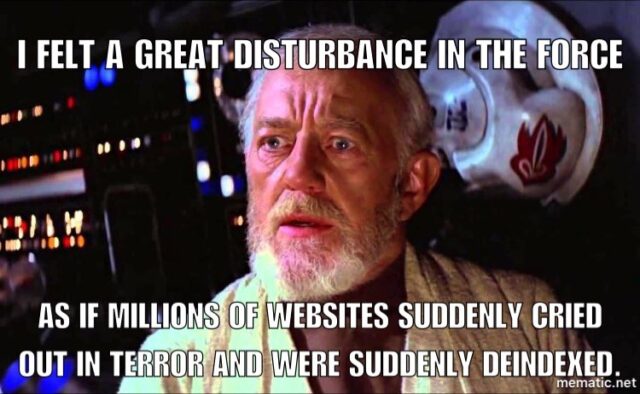
I was talking to Karl Hindle, our CEO and resident SEO nerd, about the latest Google Core Algorithm update. My concern was whether or not our clients would be affected by this update.
His answer confirmed what I suspected, “if you’re doing white-hat SEO, these updates rarely hurt and often help your rankings over time.” Now, white hat SEO is a pretty big subject, but for the purposes of this post, I will sum it up in one sentence…
White hat SEO is search engine optimization that adheres to Google’s Search Guidelines and avoids any practices that Google deems a violation.
In other words, don’t be sneaky. Focus on your clients.
This post is not about white hat SEO, specifically, it’s about Google E-A-T and how it can help with link building. I want to start with a brief overview of white hat link building…
White Hat Link Building
There are many ways to go about building quality backlinks to your website. Some of the methods are best done by an SEO firm like Wellspring Digital. That said, there are still things you can do to build these so-called quality links.
Organizational Links
These are links from reputable websites that have some organizational relevance to your website, for example, this link on the Frederick Chamber’s website where we are listed as a Partner in Trust.
I am also listed as an advisory committee member with a link back to our website in TechFrederick, another member organization. And we won this year’s coveted Tech Games trophy!

They sent out a press release about this year’s games and I noticed that our name was not linked. I ask them very nicely to change that, and they did. Just like that, another quality backlink!
Guest Posts and Interviews
These are posts you write for well-known blogs and magazine type websites. For example, I wrote this post about landing pages on Spin Sucks, a popular marketing, and communications blog.
In this post, I have links back to original content on our website as well as a link in my author profile. Google looks at these links on this trusted website as signals that I am a trusted author and that our website contains authoritative content worth linking to.
If you are lucky enough to have well-known experts in your organization, try and get them interviews on trusted industry websites. Those interviews show Google that experts in your company are valued by other organizations with authority.
And, of course, make sure there are links in those interviews back to your content and your website. For example, what we’re doing with our Wellspring Digital Chat series helps those experts being interviewed because I include links to their content in the intro and transcripts.
I also invite those guests to share the interview on their social channels and on their websites which means more high-quality backlinks for us!
Original Content on LinkedIn and Medium
This is a really straightforward and effective way to get backlinks to your content. Write original article content on sites like LinkedIn and Medium and then reference other authoritative content on your website with, you guessed it, links!
Don’t just copy content from your blog and paste it as is on those platforms. I used to tell people to do this because it did work, but Google will value this content much more if it is original. And those backlinks will have more value.
What Does a Good Backlink Look Like?
These should be clear and obvious links (using an underline or somehow indicating that it is a link) and contain relevant anchor text that is not over-optimized.
Anchor text is the text you are linking. For example, the anchor text in that last sentence is “Anchor text.” 🙂
These should also be links placed on the website by the site owner. The links in this post, because they are appropriate, useful, and placed by me, are quality links.
The links someone puts in the comments could be considered spam because they are not generated by the site owner. I’m oversimplifying a bit but you get the drift.
Quality backlinks are generally placed in the body content of the page and not in the footer. Again, the links in this post have value, especially to those websites outside of our domain because they are contextually relevant and within the body content.
Of course, you don’t always get quality backlinks by asking nicely, you have to earn them. Build E-A-T content on your website if want to attract more quality backlinks.
Google E-A-T
This is not Google’s plan for world domination or some scheme to get you to Terminus (sorry, vague Walking Dead reference).

Google E-A-T is a guideline, a suggested set of principles to follow.
E-A-T stands for…
- Expertise – you and your people know what you’re talking about, having some credentials, resume, and/or online content history to prove it. Google will use various tools in its arsenal to validate whether or not you know your stuff.
- Authoritativeness – you are considered a valuable resource within your industry, but more specifically by Google because of the content you create and because of the experts who value that content by referencing and linking to it.
- Trustworthiness – your website is safe, easy to use, and you are real with a real location, real people, and real offerings.
These principles are all outlined in Google’s Quality Rater’s Guide. A team of 1,000s of actual people uses this guide to rate the Google search results.
In this guide, Google talks about “high E-A-T pages” meaning pages that check these boxes well. These pages can be most types of pages, as long as they offer high E-A-T value. From Google, these can be…
“…high E-A-T pages and websites of all types, even gossip websites, fashion websites, humor websites, forum, and Q&A pages, etc. In fact, some types of information are found almost exclusively on forums and discussions, where a community of experts can provide valuable perspectives on specific topics.” Google’s Quality Rater’s Guide
There is a ton of great information out there on E-A-T. Lily Ray and Bill Slawski have been killing it with explorations of all things E-A-T lately. Definitely look them up.
Google E-A-T Is A Warning
E-A-T is a warning to businesses and organizations who continue to ignore quality content and white hat SEO efforts and just hope they will rank.
Let me bastardize this line from a Tool song. “Google E-A-T is a message of hope for those who choose to hear, and a warning for those who do not.”
What Google Wants
The Internet is a vast ecosystem. A large portion of that ecosystem is noise. Google is working to filter out valuable content from that noise. They want to make certain they can trust who is creating it.
This isn’t just about academic content, this is about all content on the web. Google, using a very complex system of algorithms, is looking at every website, page of content, content creators, and content distributors to determine…
- Who needs this content?
- Is it good E-A-T content?
- Does the person writing this content know what they are talking about?
- Do others think this is good content?
- How does this content relate to the search performed?
- Are searchers clicking, reading, and sharing this content?
Try and figure out how exactly they do this and your head will explode. Leave this to the SEO experts like Lily Ray and Bill Slawski. You have a business or organization to run. You have bigger fish to fry, so to speak.
Just understand that Google is telling you that content is important and can affect your rankings in the SERPs (search engine results pages) as long as it is…
- E-A-T content produced by subject matter experts
- validated by other experts
- on a website that is trustworthy
Don’t worry as much about the signals Google is looking at. Worry about the content you are creating and that you have a qualified white hat SEO supporting your onsite and offsite SEO efforts.
Once you have that content, share it!
The Future of SEO Has Been Here for a While
If you read about SEO as much as we do here, you’ve been noticing a pattern with Google. They do not like it when the SERPs list junk. They do not like it when people try to game the system.
Google Panda, Penguin, Fred, and Bert updates, aside from having odd names, were all in some way geared toward getting low quality, low-value websites out of the search results. Check out this Google update outline post from Emily Hindle (it runs in the family).

I don’t know about you, but it seems that Google has been consistent about what they want from webmasters. For example, Google specifically told webmasters…
“Several times a year, we make significant, broad changes to our search algorithms and systems. We refer to these as “core updates.” They’re designed to ensure that overall, we’re delivering on our mission to present relevant and authoritative content to searchers.” – Google Search Central Blog
Seems pretty clear to me. So, the future of SEO is all about relevant and authoritative content. Authority comes from external validation. External validation happens when you create quality E-A-T content that is shared and linked to.